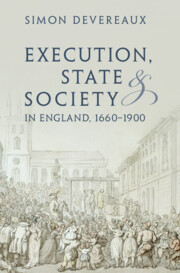Book contents
- Execution, State and Society in England, 1660–1900
- Series page
- Execution, State and Society in England, 1660–1900
- Copyright page
- Dedication
- Contents
- Figures
- Images
- Tables
- Acknowledgments
- Abbreviations
- 1 Introduction
- 2 Executions for Treason, 1660–1820
- 3 Changing Cultures of Execution: Religion and Feeling, 1660–1770
- 4 Changing Cultures of Execution: Reason and Reforms, 1770–1808
- 5 The Murder Act: Anatomization, 1752–1832
- 6 The Murder Act: Hanging in Chains, 1660–1834
- 7 The “Bloody Code” Debated, 1808–1821
- 8 The “Bloody Code” Diminished, 1822–1830
- 9 The Vicissitudes of Public Execution, 1830–1900
- 10 Conclusion
- Archival and Digital Sources
- Index
4 - Changing Cultures of Execution: Reason and Reforms, 1770–1808
Published online by Cambridge University Press: 12 October 2023
- Execution, State and Society in England, 1660–1900
- Series page
- Execution, State and Society in England, 1660–1900
- Copyright page
- Dedication
- Contents
- Figures
- Images
- Tables
- Acknowledgments
- Abbreviations
- 1 Introduction
- 2 Executions for Treason, 1660–1820
- 3 Changing Cultures of Execution: Religion and Feeling, 1660–1770
- 4 Changing Cultures of Execution: Reason and Reforms, 1770–1808
- 5 The Murder Act: Anatomization, 1752–1832
- 6 The Murder Act: Hanging in Chains, 1660–1834
- 7 The “Bloody Code” Debated, 1808–1821
- 8 The “Bloody Code” Diminished, 1822–1830
- 9 The Vicissitudes of Public Execution, 1830–1900
- 10 Conclusion
- Archival and Digital Sources
- Index
Summary
As soon as newspapers, catering to England’s new urbane peoples, began describing common executions, the crowds attending them were seen as indifferent to their moral message. By the middle of the eighteenth century, execution rituals seemed equally problematic. Critics perceived hangings to be so frequent, so large-scale and so brutalizing to an even minimally refined sensibility as to defeat their deterrent purpose. In 1783, London officials sought to redress these problems by devising a new execution ritual, staged immediately outside the prison and courthouse. Within four decades, this quintessentially urban execution ritual had been adopted in almost all other English counties, even as cities on the continent pointedly moved executions outside urban centres. Yet still executions seemed ineffective. Following a particularly intense crisis in the 1780s, England’s traditional ruling elites sought to preserve the “Bloody Code” by reducing the scale of hangings to historically low levels.
Keywords
- Type
- Chapter
- Information
- Execution, State and Society in England, 1660–1900 , pp. 94 - 140Publisher: Cambridge University PressPrint publication year: 2023

